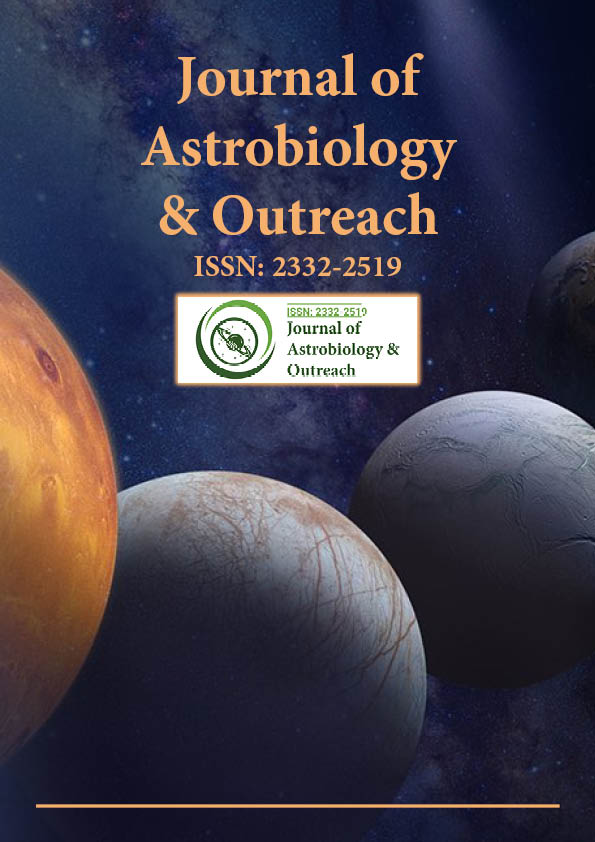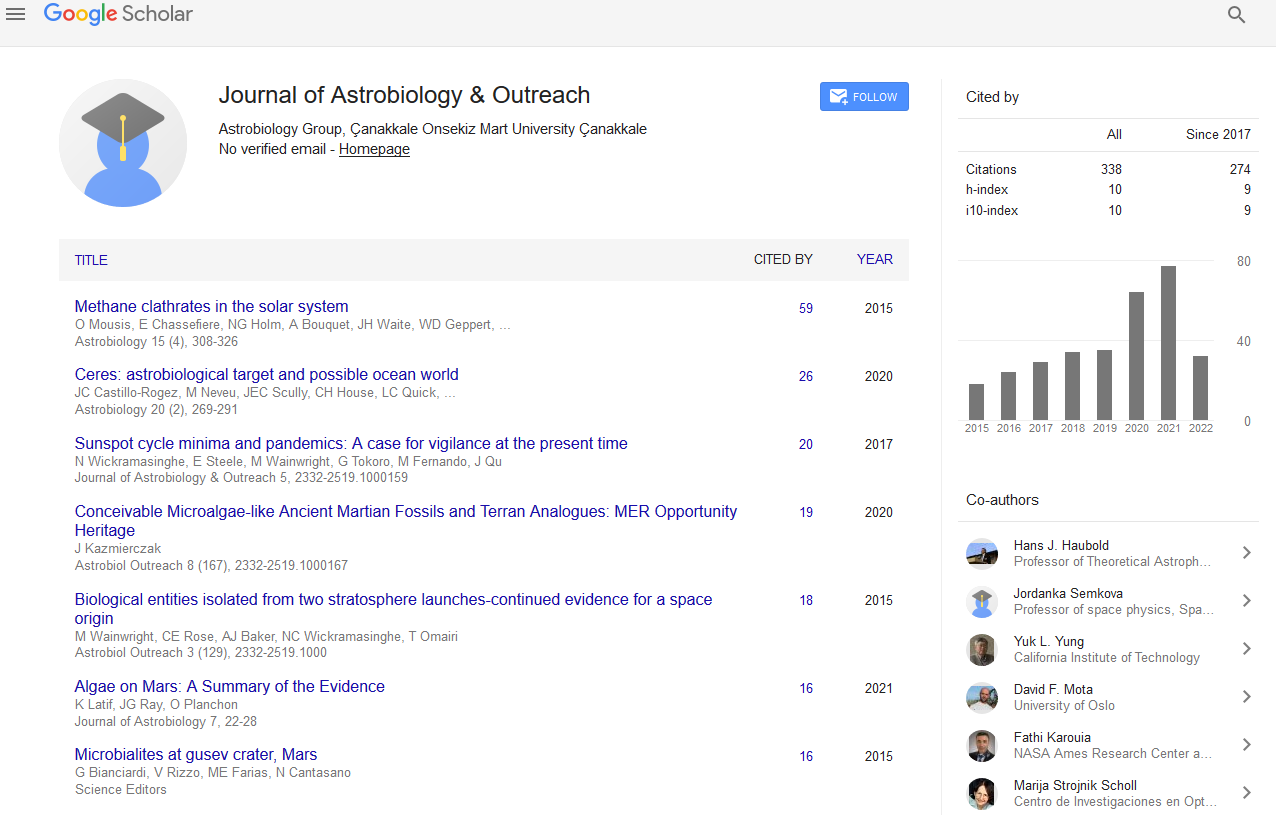Indexed In
- Open J Gate
- Academic Keys
- JournalTOCs
- RefSeek
- Hamdard University
- EBSCO A-Z
- OCLC- WorldCat
- Google Scholar
Useful Links
Share This Page
Journal Flyer

Open Access Journals
- Agri and Aquaculture
- Biochemistry
- Bioinformatics & Systems Biology
- Business & Management
- Chemistry
- Clinical Sciences
- Engineering
- Food & Nutrition
- General Science
- Genetics & Molecular Biology
- Immunology & Microbiology
- Medical Sciences
- Neuroscience & Psychology
- Nursing & Health Care
- Pharmaceutical Sciences
Commentary - (2023) Volume 11, Issue 3
Lichens: Pioneering Biomaterials Unveiled through Astrobiology Experiments
Chybi Joseph*Received: 01-May-2023, Manuscript No. JAO-23-21755; Editor assigned: 03-May-2023, Pre QC No. JAO-23-21755 (PQ); Reviewed: 17-May-2023, QC No. JAO-23-21755; Revised: 24-May-2023, Manuscript No. JAO-23-21755 (R); Published: 31-May-2023, DOI: 10.35248/2332-2519.23.11.294
Description
Astrobiology, the study of life's existence beyond earth, has not only deepened our understanding of the cosmos but also yielded unexpected discoveries with practical applications. Lichens, symbiotic organisms composed of fungi and algae, have recently emerged as new and promising materials resulting from experiments in astrobiology. This study explores the exciting potential of lichens as versatile biomaterials and highlights how their study in astrobiology has implications for various fields, including materials science, medicine, and sustainability.
Lichens as biomaterials
Lichens, renowned for their ability to survive in extreme environments, possess unique characteristics that make them attractive biomaterials. Astrobiology experiments have shown that lichens can withstand harsh conditions, including radiation, extreme temperatures, and limited resources. This resilience and adaptability have sparked interest in harnessing their properties for various applications.
One area where lichens show immense potential is in materials science. Researchers have discovered that lichens can accumulate and store metals from their surrounding environment, making them natural bio indicators for pollution monitoring. This capacity opens doors for developing innovative techniques to remediate contaminated areas and extract valuable metals. Furthermore, lichens' structural integrity, along with their ability to absorb and retain water, suggests their potential use in biomaterials for building construction, textiles, and even biodegradable packaging materials.
Medical and pharmaceutical applications
The exploration of lichens in astrobiology has unveiled their hidden potential in the medical and pharmaceutical fields. Lichens produce a vast array of secondary metabolites, including antimicrobial compounds, which they use for defense against pathogens and to survive in harsh conditions. These bioactive substances have shown promise as natural alternatives for antibiotics and antifungal drugs, especially in the face of growing drug resistance.
Additionally, astrobiology experiments have revealed that lichens possess antioxidant properties, making them potential sources of novel compounds for the development of drugs and treatments for oxidative stress-related diseases. Research also indicates the presence of anticancer compounds in certain lichen species, opening avenues for the discovery of new therapies.
Sustainable solutions
In an era of increasing environmental concern, lichens offer sustainable solutions across various industries. The ability of lichens to absorb pollutants and their potential for bioremediation can contribute to tackling environmental challenges such as air pollution and soil degradation. Lichens can be utilized in urban environments to monitor air quality, providing valuable data for pollution management and urban planning.
Furthermore, lichens' capability to photosynthesize and thrive in nutrient-poor conditions positions them as potential sources of food and bioenergy. Researchers are exploring the use of lichens in biotechnology processes, including the production of biofuels and as a source of nutrition in controlled environment agriculture. These applications have the potential to contribute to sustainable food production and renewable energy generation.
Conclusion
Experiments in astrobiology have shed light on the incredible potential of lichens as versatile biomaterials. From their adaptability to extreme conditions to their unique properties and bioactive compounds, lichens offer a wide range of applications in materials science, medicine, and sustainability. Further research and collaboration between astrobiologists, materials scientists, and industry experts are needed to fully unlock the potential of lichens and translate their discoveries into practical solutions. By harnessing the power of these ancient symbiotic organisms, we can create a sustainable future that benefits both human well-being and the health of our planet.
Citation: Joseph C (2023) Lichens: Pioneering Biomaterials Unveiled through Astrobiology Experiments. JAstrobiol Outreach. 11:294.
Copyright: © 2023 Joseph C. This is an open-access article distributed under the terms of the Creative Commons Attribution License, which permits unrestricted use, distribution, and reproduction in any medium, provided the original author and source are credited.

